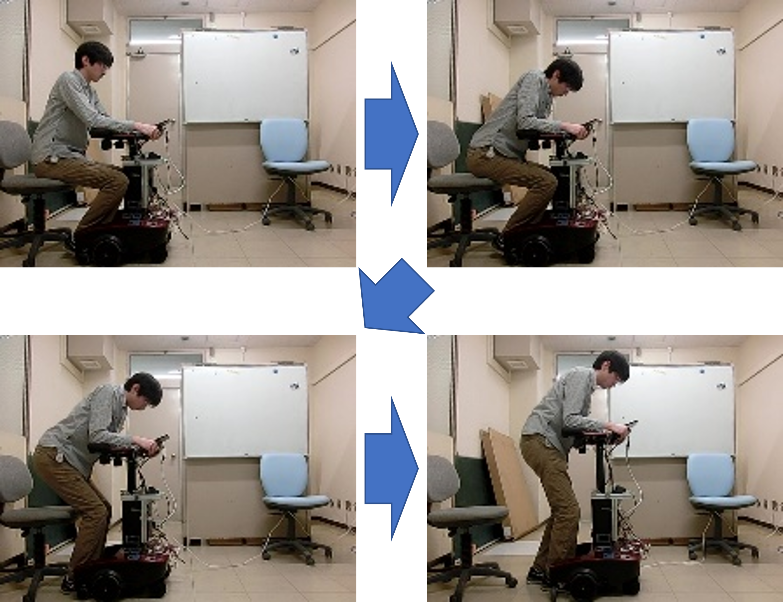
ここからコンテンツです。

A robot assisting elderlies in standing up, walking, and sitting down
Recognizing the state of users through few sensorsMizuki Takeda
A research team led by Mizuki Takeda, an assistant professor at the Department of Mechanical Engineering in Toyohashi University of Technology has developed a robot that can assist people in standing up, walking, and sitting down by estimating the user's state using a small number of sensors. They have developed a technique for a robot to estimate a user's state with few sensors by calculating center of gravity candidates. Knowing the state of the user, such as whether they are trying to stand up or sit down, makes it possible to provide assistance as necessary. Moreover, it can prevent accidents by detecting irregularities, such as the user almost falling over.

Elderly people, whose muscle strength weakens with age, may need to receive assistance in their daily lives, so robots are being developed to assist with especially frequent actions such as standing up and walking. Conventional robots have normally assisted in one of these actions, but since standing up, walking, and sitting down are done in sequence, it is desirable to have a single robot assist with them all.
Moreover, large-scale systems are often constructed to produce great force or recognize the user's state in detail, but systems for household use should ideally be small and have few sensors. If all movements are initiated by the robot, it may lead to dissatisfaction on two counts: muscular weakening and a reduced sense of independence on the part of the users. As such, they have developed a robot that allows the user to initiate movement and assists as appropriate by recognizing the user's situation and adding the force that is missing.
The research team focused on center of gravity as a key to estimating the robot user's state. Center of gravity is effective as an indicator of a person's state, cannot be accurately assessed with only a few sensors, so they developed a technique for calculating the range where center of gravity candidates can be found by considering data such as the motion range of joints. They produced a robot that uses these center of gravity candidates to estimate the user's state and detect irregularities through a type of machine learning called support vector machine and then move according to that information.
The research team believe that estimation of people's states using center of gravity candidates can be applied to welfare robots of various shapes and uses. Moreover, they want to make robots easier to use for elderly users by better understanding what movements the robots are expected to perform and how they should communicate with the users.
Reference
Mizuki Takeda, Kaiji Sato, Yasuhisa Hirata, Takahiro Katayama, Yasuhide Mizuta, and Atsushi Koujina (2021). Standing, Walking, and Sitting Support Robot Based on User State Estimation Using a Small Number of Sensors. IEEE Access.
doi: 10.1109/ACCESS.2021.3127275
高齢者の起立・歩行・着座を支援するロボット
少ないセンサで使用者の状態を認識する武田 洸晶
豊橋技術科学大学機械工学系 武田 洸晶助教らの研究チームは、少数のセンサを用いて使用者の状態を推定して動作する起立・歩行・着座支援ロボットを開発しました。重心位置の候補点を計算することで、少ないセンサでロボット使用者の状態を推定する手法を開発しました。使用者が立とうとしている、座ろうとしているなどの状態が分かることで、それに応じて必要な支援を行うことを可能とします。また、転倒しそうな状態などの異常を検知することで、事故を防ぐ機能も実現しました。
筋力の衰えた高齢者の日常生活の支援が望まれており、特に頻繁に行う起立や歩行などを支援するロボットの開発が進んでいます。従来のロボットはこれらの動作一つ一つを支援するものが主流ですが、起立・歩行・着座は一連の動作として行われるため、一台のロボットで支援することが望ましいです。また、大きな力を発生させたり使用者の状態を詳細に認識したりするために大掛かりなシステムが作られる事が多いですが、家庭で使うには小型でセンサも少ないシステムが望まれます。動作を全てロボットが主体となって動かしてしまうと、筋肉の衰えを促進したり運動主体感の減少による不満を発生させたりします。そこで、ロボット使用者が主体となって動作をし、その様子を把握することで足りない力を適切に支援するロボットを開発しました。
研究チームはロボット使用者の状態を推定するために、重心位置に着目しました。重心位置は人の状態を表す指標として効果的ですが、少ないセンサでは正確な重心位置を求めることはできません、そこで関節の可動域などを考慮することで、重心位置の候補が存在する範囲を計算する手法を開発しました。この重心候補を使って、サポートベクターマシンという機械学習により使用者の状態推定および異常検知を行い、それに応じて動作するロボットを製作しました。
研究チームは、重心候補を用いた人間の状態推定は様々な形状・用途の福祉ロボットに適用可能であると考えています。また、使用する高齢者にとってより使いやすいロボットとするために、ロボットがすべき動作や、人間とのコミュニケーション方法を明らかにしたいと考えています。
Researcher Profile

| Name | Mizuki Takeda |
|---|---|
| Affiliation | Department of Mechanical Engineering |
| Title | Assistant Professor |
| Fields of Research | Robotics / Human-Robot Interaction / Care Robot / Robot Ethics |
ここでコンテンツ終わりです。
